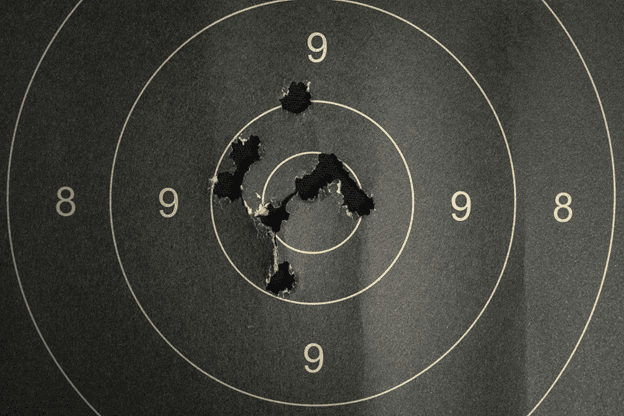Just like the type of bullet you choose, the bullet’s weight, in grains, will significantly impact your shooting experience, as well as how successful you are, given the shooting discipline.
Moreover, barrel twist rate, like barrel length, can impact accuracy. Here’s a primer on rate of twist and the performance of the 75-grain FMJ American Eagle .223 we sell here.
What Is the Rate of Twist and Why Does It Matter?
A barrel’s rate of twist, also known as twist rate, is the linear distance through the bore that a bullet must travel in order to complete one revolution around its centerline axis.
Rate of twist is expressed as a ratio, such as 1:8 or 1:10. In the former case, a bullet must travel 8 inches to complete one axial revolution; in the latter, 10.
Now here’s the important thing to remember about the rate of twist; even for a specific cartridge, like .223, there is not one fixed rate of twist that will perform well.
Bullet weight and speed both impact this, primarily bullet weight. Here’s what you should remember: as a general rule, a more aggressive twist rate tends to work better with heavier bullets, whereas a slower twist rate offers better performance with lighter bullets and slower burning powders.
Since we’re working with modern smokeless powder here, the main determinant we need to consider is bullet weight.
It’s also important to match a barrel with an appropriate twist rate for the ammo you shoot; regardless of whether the twist rate is too high or not high enough, accuracy can potentially suffer.
How About 75-Grain American Eagle .223?
The 75-grain American Eagle .223 that we sell here, and which is the focus of this article, is right in the middle of the road in terms of .223 bullet weights - if not a little bit on the heavier side.
Therefore, it will perform better with a barrel that has a more aggressive rate of twist. This ammo will experience optimal performance in a barrel that has an aggressive twist rate of 1:8, 1:7, even as quick as 1:6.
Not that a barrel with a 1:10 twist rate will shoot poorly and inaccurately, but you might from time to time see fliers and other aberrations that would be eliminated by a barrel with a faster twist rate.
The other thing to note about this ammo is that, since they’re loaded with heavier bullets, they’ll drop faster. This doesn’t make them bad for long-range shooting. In fact, because the bullet is heavier, it will resist wind drift more. Therefore you just need to account for bullet drop, and zero and hold over accordingly.
Another thing you should consider is to get a longer barrel. A 16-inch carbine barrel won’t produce the same muzzle velocity as a rifle-sized 20 or 22-inch barrel, and with that higher muzzle velocity, you’ll get a little bit less bullet drop for greater performance at longer ranges.
What’s the Best .223 Grain Ammo?

There is no single .223 ammo, in terms of weight, that is the objective best. Rather, in terms of bullet weight, there are some general observations you could make.
Lighter .223 ammo, between 35 and 50 grains, will experience more wind drift during long range shooting, but less bullet drop. It will also not carry as much ballistic energy, so it is better for target shooting and varmint dispatch than it is for hunting larger game.
Also, remember that these lighter bullets need a barrel with a slower twist rate for optimal performance and accuracy.
Heavier bullets, between 50 and 70 grains, will require a faster rate of twist and will drop faster, but will be less affected by wind drift. They will also produce higher muzzle energy and therefore carry more energy to the target, making them more effective (with an appropriate bullet) for sporting and defensive applications.
The heaviest .223 bullets, north of 70 grains and going up to near 90 grains, require the most aggressive rates of twist for stability, but are the best for hunting and defensive applications, especially if your target species is on the larger or tougher size.
Remember in all of these applications that bullet type matters just as much as bullet weight, and that a hollow point or ballistic point bullet will almost always outperform a jacketed bullet for defensive applications or hunting, whereas a more stable FMJ or open-tip match round will be not only more affordable, but perform better, in terms of accuracy, for competition, precision, or long-range shooting.
Stock Up on .223 Bulk Ammo Here
Whether you’re here for the American Eagle .223 in question or are here for .223 bulk ammo, get what you need and restock your ammo cans today. We carry a wide range of options at competitive prices - check out our deals and police trade-in specials while you’re here so you don’t miss a steal.

